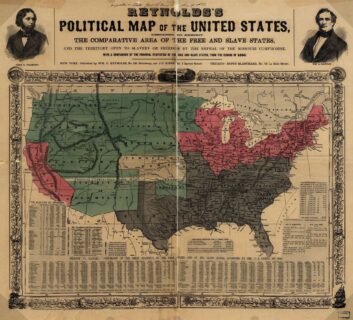
John Brown's Legacy: From Kansas to the Classroom
I have a confession to make. In my years teaching American history, I did an inadequate job teaching students about the notorious abolitionist John Brown, his activities in Kansas during the 1850s, and his infamous raid on Harpers Ferry. Typically, I described the Kansas-Nebraska Act, how it led to the violence in Kansas known as “Bleeding Kansas,” showed a brief clip on Brown from The American Experience documentary The Abolitionists, and moved on. Lincoln, as every American history teacher knows, must be assassinated by Christmas. I discovered my shortcomings during a recent Teaching American History seminar entitled: John Brown’s Legacy: From Kansas to Harpers Ferry.
TAH is perhaps best known for our database of primary source documents, all in the public domain and free for teachers to use with their students. However, we also provide content professional development for secondary teachers of United States history and government. Before the disruption caused by COVID-19, our One-Day seminars consisted of three 90 minute sessions. Each session focused on sub-topics related to the overall seminar topic. Post-COVID, our seminars have moved online. We offer programs of various lengths to accommodate Zoom fatigue and the extraordinary demand on teachers in the current climate.
Like all of our seminars—whether one- or multi-day professional development opportunities or graduate level-courses—the John Brown seminar I recently attended had three essential components. It centered on primary documents, engaged a conversation about them, and was led by a scholar with expertise in the material. Dr. Will Atto of the University of Dallas led us on this day. Will curated the reading packet and formulated the guiding questions that were sent to participants two weeks ahead of the seminar. Teachers prepared well for the discussion, which took place in two 90-minute sessions.
In the first session, Will asked us to consider the recommendations Brown and Frederick Douglass made for abolitionist success in Kansas. We compared two documents I was unfamiliar with—Douglass’s “Our Plan for Making Kansas a Free State” (September 15, 1854) and Brown’s 1851 “Words of Advice” to the Gileadites, an abolitionist organization of fugitive enslaved persons then facing a renewed threat of capture because of the recently passed Fugitive Slave Law of 1851. In his advice to the Gileadites, Brown suggested the fugitives prepare themselves for armed self-defense, should it prove necessary. Will asked us if this meant Brown was contemplating violence as early as 1851?
I listened with fascination as the group of teachers attending the seminar dug into the documents. One seminar participant captured my thoughts about not teaching Brown in depth. “Students tend to focus on the crimes of John Brown,” she said, “not his calls for abolition.” Another teacher suggested a reason for Brown’s violent raids. She doubted Douglass’s claim that large numbers of white sympathizers were inclined to join Brown and other abolitionists’ peaceful efforts to make Kansas a free state. Consequently, she doubted the efficacy of Douglass’s plan.
Will Atto asked us to consider the context. Did the Fugitive Slave Law’s threat to freedmen push Brown towards a more militant posture? In response, a middle school teacher from South Carolina placed the Kansas documents into a national context. Perhaps the knowledge that white slave owners were not reluctant to use “force to enforce their racial vision” motivated Brown’s willingness to use violence in attacking slavery.
I was familiar with the documents Will selected for our second session, but now I was curious to see what the teachers in the seminar would make of them. Brown’s “Last Speech” suggests his motive for the raid on Harpers Ferry was to “carry” enslaved persons from Virginia’s highlands into freedom in Canada. Several participants commented on Brown’s messianic vision and repeated invocation of the Golden Rule as a call for enslaved persons’ emancipation. Once he believed he was God’s messenger, they agreed, it was easy for Brown to justify the means necessary for what he saw was God’s work.
One participant speculated about the public reaction to a woman willing to martyr herself for the abolitionist cause. Would 19th century Americans judge a female activist who took up arms to be acting as nobly as Brown? Or would they view her actions as unladylike, even obscene? Would even the 21st century United States honor an American Joan of Arc?
These questions arose during our discussion of a remarkable exchange of letters between abolitionist Lydia Maria Child and Virginia Governor Henry Wise. Child sought Wise’s permission to visit Brown in prison. She claimed not to “know a single person who would have approved” Brown’s raid. She only wished to do her Christian duty – “dress his wounds and speak soothingly to him” as he prepared for the gallows. In his condescending reply, Wise said she could visit if she wished but warned her that the appearance might incite violence because of her “warm support” for Brown. Child then hit with a full-throated defense of abolitionism. This exchange offers numerous opportunities for classroom discussion – from the role of women in 19th century American politics to the increasing sectionalism exacerbated by Brown’s raid on Harpers Ferry.
The seminar concluded with the timeless question: Was Brown a martyr or a terrorist? We discussed Horace Greeley’s assessment that Brown was a madman, contrasted with Douglass’s assertion that Brown was not insane. We also discussed a very teachable excerpt from Abraham Lincoln’s pivotal Cooper Union Address in February 1860, in which he defended his Republican Party against accusations that its “doctrines and declarations necessarily” led to insurrections of enslaved persons. Lincoln described the Harpers Ferry Raid as “an attempt by white men to get up a revolt among the slaves, in which the slaves refused to participate” (Lincoln, Address at Cooper Institute, February 27, 1860). All three of these documents are concise. Students can readily use them to develop their assessment of Brown’s legacy.
When I was a classroom teacher, I attended TAH seminars for two reasons. One was to feed my passion for the subject by spending time with colleagues who share the same passion. But I also expected to take a few documents discussed in the seminar and incorporate them into my curriculum – either directly, by assigning the document or indirectly, by deepening my understanding of the nuances thus enabling me to teach the topic more effectively.
So, how would the seminar change my teaching about Brown? I would use the primary sources written by Douglass and Brown from Session One to help students understand how the Kansas-Nebraska Act and subsequent violence, known as “Bleeding Kansas,” foreshadowed the brutal fighting in the Civil War. After teaching students the details of the attack on Harpers Ferry, I would give students the excerpts from Greeley, Douglass, and Lincoln and ask them to respond to a variety of prompts on Brown’s legacy. How do they see Brown? A terrorist, as many Southerners at the time thought? Or was Brown a hero for attempting to end slavery, regardless of the violent, and arguably insane methods he employed?


